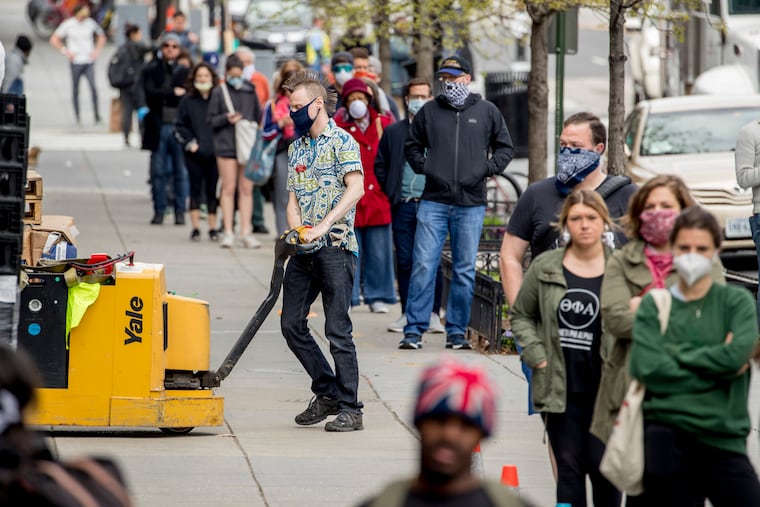Why the U.S. economy won’t fully recover until the mid-2020s, says Moody’s Mark Zandi
A necessary condition is a vaccine, which seems on track for mid next year, experts say. Until then, any economic recovery will remain a slog, characterized by halting growth and high single-digit unemployment. And even then, the economy won’t fully recover until mid-decade.

As infections from COVID-19 peak, so, too, does the economic fallout from the virus. The statistics in coming weeks will be grim, but a recovery should begin by Memorial Day. The critical question is how strong a recovery. Unfortunately, not very, at least not until there is a vaccine in widespread use, and even then the economy will take years to fully recover.
First, the statistics. The virus is causing unprecedented economic damage. The jobs lost this month will top more than 20 million. This will entirely wipe out the increase in jobs during the previously record-long economic expansion.
Unemployment will surge to more than 15%, far and away the highest unemployment rate since the 1930s Great Depression. And this significantly understates the stress in the job market, because many of the unemployed will not be actively looking for work (because they can’t) and thus won’t be counted as unemployed by government statisticians. A broader measure of underemployment that includes these workers will approach a mind-boggling 25%.
This should be the worst of it, as some businesses across the country appear likely to reopen in coming weeks. Governors of many states are under intensifying pressure to ease the lockdowns regardless of whether this makes the most sense in combating the virus.
Construction will open up first, if it isn’t already considered an essential activity as it is in some states, as will manufacturing and some personal, financial and professional services. These are some highly productive industries, and their reopening will lift GDP (the value of all things we produce) and jobs.
» HELP US REPORT: Are you a health care worker, medical provider, government worker, patient, frontline worker or other expert? We want to hear from you.
Job losses should thus turn to job gains by then, in part because of the easing of the business shutdowns, but also because of the federal government programs implemented in the fiscal rescue legislation. Part of the legislation is designed to help small businesses with loans that become grants if the bulk of the money pays worker wages. Businesses receiving the money will bring back some of their laid-off workers.
With businesses restarting and the federal government and Federal Reserve providing massive support, the recession will end this summer and the economy will enjoy a bounce. By the fall, unemployment should be back in the high single digits.
Of course, this presupposes that the business restart and the scaling back of social distancing rules will not reignite more infections, hospitalizations and deaths. This is a big if, particularly because there is unlikely to be the kind of widespread testing for the illness and its antibodies necessary to quickly track down and quarantine the sources of new infections. A serious second wave of the virus would be fodder for a cataclysmic double-dip recession and what would likely be considered an economic depression.
The restart of the Asian economy, which began two months ago, is a cautionary tale. Many Asian countries were aggressive in responding to the virus, imposing severe lockdowns and social distancing rules and engaging in widespread testing. Infections and deaths were limited, at least compared with Europe and the U.S. But the virus isn’t going away, and Asian nations are still grappling with how to contain it.
Even if the U.S. business restart goes reasonably well, and the virus remains largely contained, a surge in business failures and bankruptcies is likely and will impede any economic recovery. Too many of the unemployed won’t have jobs to go back to. New businesses will ultimately form and fill the void, but that will take time.
Households will also struggle to pay their debts. Many homeowners with government-backed mortgage loans caught a break. They can receive forbearance on their mortgage payments for up to a year. However, with unemployment likely to remain high and house prices to weaken, foreclosures are sure to increase.
As losses on these loans mount, the financial system and markets will come under renewed pressure. The Federal Reserve has done an admirable job standing up a firewall between the severe economic downturn and the financial system. It did this by quickly pushing interest rates down nearly to zero, easing up on the banks, buying the Treasury bonds needed to finance the government’s rescue package, and fully backstopping the financial system. So the stock market has rallied and credit continues to flow.
But the Fed’s firewall will almost surely be tested again once investors actually see the extent of the losses from the failures, bankruptcies and defaults. A necessary condition for any kind of economic recovery is for the firewall to hold.
A necessary and sufficient condition is a vaccine. That seems on track for the middle of next year, according to the health experts. Until then, any economic recovery will remain something of a slog, characterized by halting growth and high single-digit unemployment. And even then, the economy won’t be in full swing and fully recovered until mid-decade.